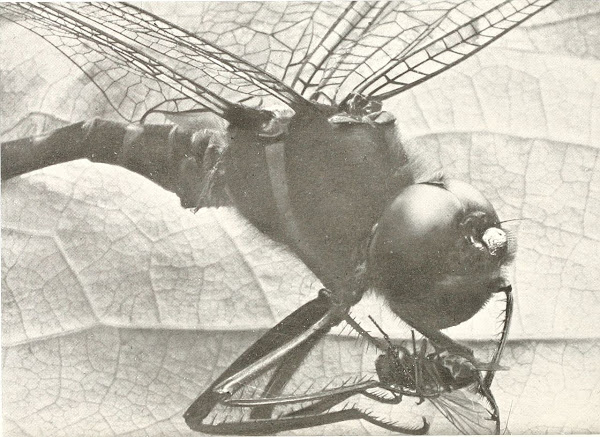Summary: North American mountain river cruiser dragonfly habitats get big eyes, brown wings, dark, long, spiny legs, slant-striped thoraxes and spotted abdomens.
North American mountain river cruiser dragonfly habitats attract cultivators with clean water and naturalists with distribution ranges between Alabama and Mississippi and into Georgia, South Carolina, North Carolina, Virginia, Tennessee and Kentucky.
Mountain river cruisers bear their common name for long male mate-seeking patrols of mountain rivers and the scientific name Macromia margarita (Margaret's equally long [large dragonfly]). The species' scientific name margarita commemorates Margaret Lucille Shepherd Westfall (Aug. 5, 1921-Feb. 9, 2000), wife of Minter Jackson Westfall, Jr. (Jan. 28, 1916-July 20, 2003). Scientific designations defer to descriptions in 1947 by Dr. Westfall, co-founder of the International Odonata Research Institute and entomologist at the University of Florida in Gainesville.
Mountain river cruiser dragonfly life cycles expect clean Piedmont and rocky mountain rivers and streams with good currents, open woodlands and perch-friendly waterside shrubs and trees.
June through August function as earliest to latest flight seasons even though June furnishes wildlife mapping opportunities in all of North America's mountain river cruiser niches.
Mountain river cruisers go from night-time resting roosts to daytime hunting, patrolling and pre-mating perches on stems and twigs in brushy, shrubby, woody nearby waterside vegetation. Each morning they head back and forth over the same 100-yard (91.44-meter) shorelines alongside, and stretches of, southeastern rivers and streams at swift sustained cruising speeds. They imprison aquatic and terrestrial low-flying and low-lying motionless and moving invertebrate prey within black, clawed, long, ridged, spiny, three-segmented legs and projectable, retractable lower lips.
Ants, biting midges, ducks, falcons, fish, flycatchers, frogs, grebes, lizards, robber flies, spiders, turtles and water beetles and mites jeopardize North American mountain river cruiser habitats.
Immature mountain river cruiser dragonflies keep dull, faded, light, pale colors and small sizes even though adults know brilliant blacks, greens and yellows and large sizes.
Incomplete metamorphosis links green, round eggs laid by females at high speeds over water surfaces, little adult-like, multi-molting, nonflying larvae, naiads or nymphs and molted tenerals. Brown-eyed, shiny-winged, soft-bodied, weak-flying tenerals manage physical and sexual maturation away from water and move back to mate in trees and manipulate eggs into ovipositing sites. River cruiser members of the Macromiidae cruiser family need aphids, beetles, borers, caddisflies, copepods, crane flies, dobsonflies, gnats, leafhoppers, mosquitoes, rotifers, scuds, water fleas and worms.
North American mountain river cruiser habitats offer season-coldest temperatures, north- to southward, from minus 5 to 0 degrees Fahrenheit (minus 20.55 to minus 17.77 degrees Celsius).
Beech, bellflower, birch, bladderwort, cattail, daisy, grass, greenbrier, heath, laurel, madder, maple, nettle, olive, pepperbush, pine, pondweed, rush, sedge, water-lily and willow families promote mountain river cruisers.
Brown-tinted wings, single-, yellow-, side-striped black thoraxes, small yellow eyespots, yellow-banded black faces and yellow-spotted black abdomens with interrupted yellow rings qualify as adult female hallmarks. Adult males reveal the same shiny black bodies and yellow spots and stripes even though they retain big, bright green eyes and clubbed, not cylindrical, abdomens. Adults show off 2.84- to 3.07-inch (72- to 78-millimeter) head-body lengths, 49- to 57-inch (1.93- to 2.24-millimeter) abdomens and 1.81- to 2.05-inch (46- to 52-millimeter) hindwings.
Single-, slant-striped thoraxes and spotted abdomens with one broken ring tell big-eyed, brown-winged, spiny-legged mountain river cruisers from other odonates in mountain river cruiser dragonfly habitats.
Acknowledgment
My special thanks to talented artists and photographers/concerned organizations who make their fine images available on the internet.
Image credits:
Image credits:
Mountain River Cruiser damselfly (Macromia margarita) belongs to the Macromia genus; Macromia species with prey depicted as "The Dragonfly and its Victim" in D. and M. Fairchild, Book of Monsters (1914), page 194: No known restrictions, via Wikimedia Commons @ https://commons.wikimedia.org/wiki/File:Book_of_monsters_(1914)_(19776390044).jpg
The Mountain River Cruiser damselfly (Macromia margarita) is found in the American Southeast (Alabama, Georgia, Kentucky, Mississippi, North Carolina, South Carolina, Tennessee, Virginia); NOAA-20 Visible Infrared Imaging Radiometer Suite (VIIRS) satellite image of Southeastern United States obtained Dec. 13, 2017, at 18:54 Coordinated Universal Time (UTC): Public Domain, via Wikimedia Commons @ https://commons.wikimedia.org/wiki/File:SE_United_States_on_Dec_13_2017.jpg
For further information:
For further information:
Abbott, John C. Dragonflies and Damselflies of Texas and the South-Central United States: Texas, Louisiana, Arkansas, Oklahoma and New Mexico. Princeton NJ; Oxford UK: Princeton University Press, 2005.
Beaton, Giff. Dragonflies & Damselflies of Georgia and the Southeast. Athens GA; London UK: University of Georgia Press, 2007.
Berger, Cynthia. Dragonflies. Mechanicsburg PA: Stackpole Books: Wild Guide, 2004.
Bright, Ethan. "Macromia Rambur, 1842 (River Crusiers)." Aquatic Insects of Michigan > Odonata (Dragon- and Damselflies) of Michigan > Anisoptera Selys, 1854 -- Dragonflies > Macromia Rambur, 1842 (River Crusiers).
Available @ http://www.aquaticinsects.org/sp/Odonata/sp_oom.html
Available @ http://www.aquaticinsects.org/sp/Odonata/sp_oom.html
Fairchild, David and Marian. 1914. "The Dragonfly and Its Victim." Pages 194-195. Book of Monsters: Portraits and Biographies of a Few of the Inhabitants and Woodland and Meadow. Washington DC: National Geographic Society.
Available via Internet Archive @ https://archive.org/details/bookofmonstersby00fair/page/194/mode/1up
Available via Internet Archive @ https://archive.org/details/bookofmonstersby00fair/page/194/mode/1up
"Macromia margarita." James Cook University-Medusa: The Odonata - Dragonflies and Damselflies > Anisoptera > Macromiidae > Macromia.
Available via James Cook University-Medusa @ https://medusa.jcu.edu.au/Dragonflies/openset/displaySpecies.php?spid=717
Available via James Cook University-Medusa @ https://medusa.jcu.edu.au/Dragonflies/openset/displaySpecies.php?spid=717
Paulson, Dennis. Dragonflies and Damselflies of the East. Princeton NJ: Princeton University Press, Princeton Field Guides, 2011.
"The 2012 USDA Plant Hardiness Zone Map." The National Gardening Association > Gardening Tools > Learning Library USDA Hardiness Zone > USDA Plant Hardiness Zone Map.
Available @ https://garden.org/nga/zipzone/2012/
Available @ https://garden.org/nga/zipzone/2012/
Westfall, M.J. (Minter J.), Jr. "A New Macromia From North Carolina." Journal of the Elisha Mitchell Scientific Society, vol. 63, no. 1 (June 1947): 32-36. Chapel Hill NC: University of North Carolina Press, 1947.








No comments:
Post a Comment
Note: Only a member of this blog may post a comment.